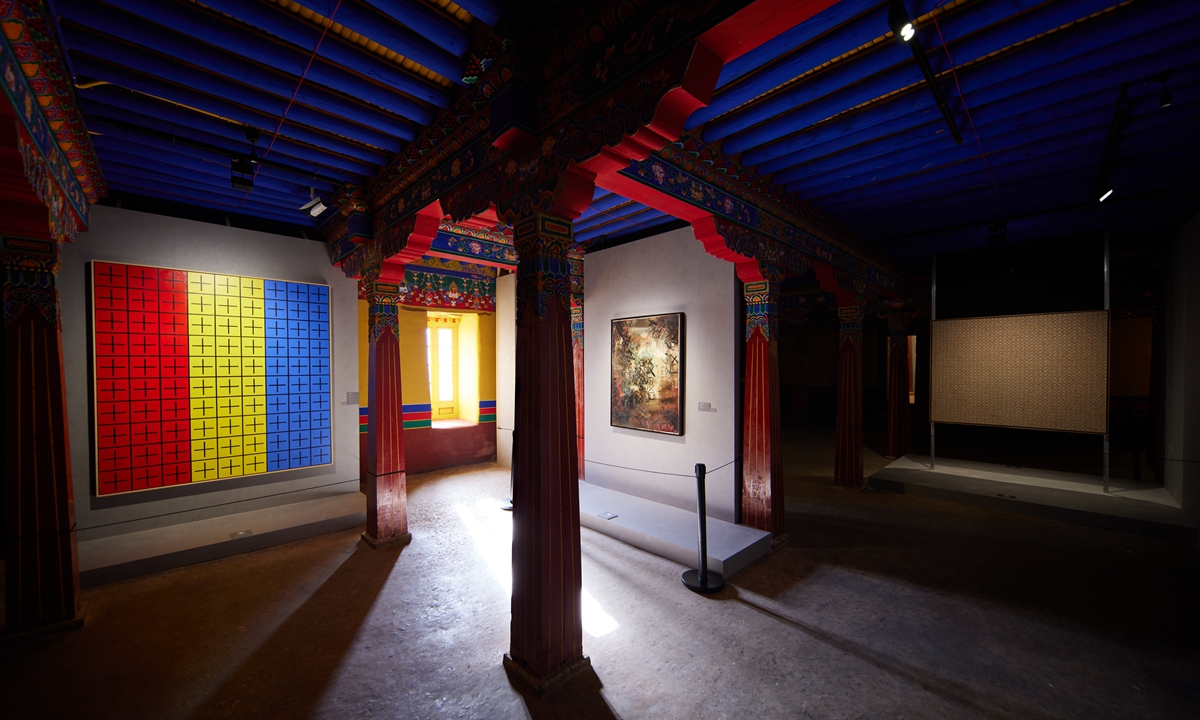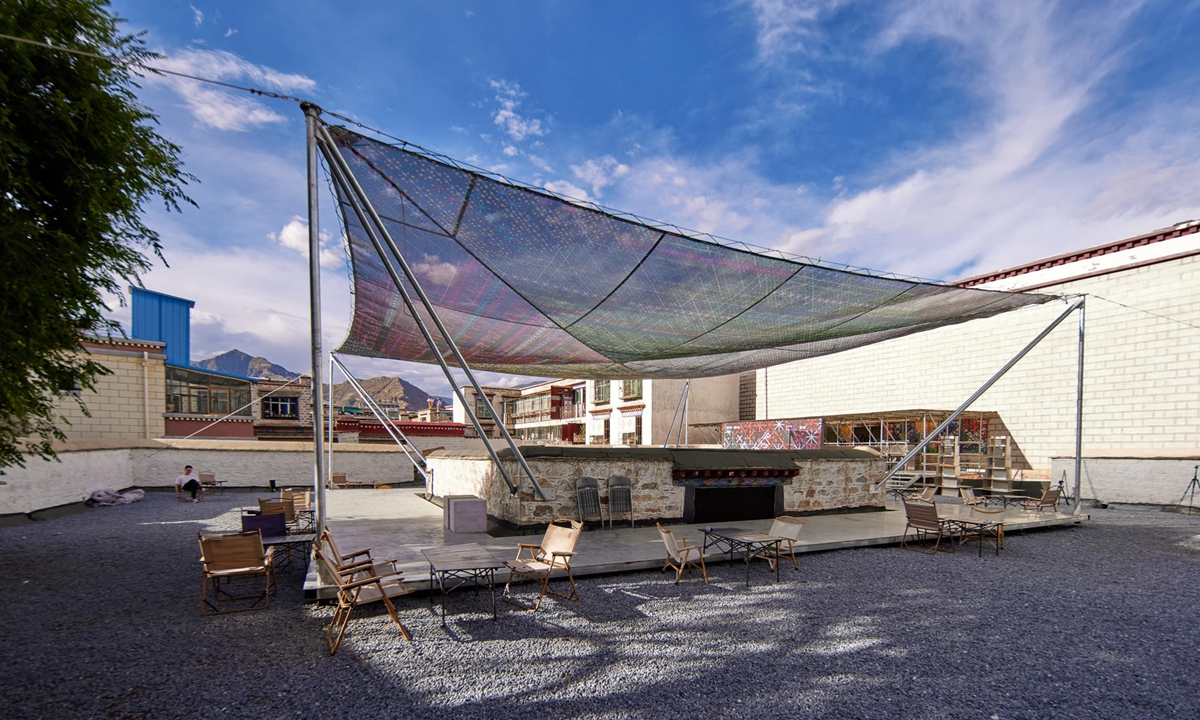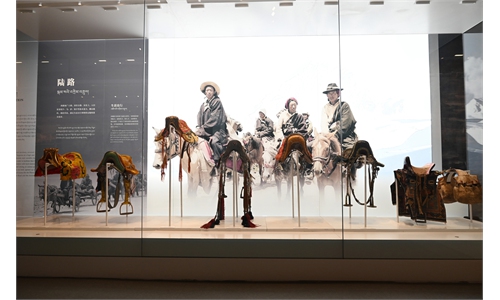ARTS / ART
Destroyed ancient Buddhist temple in Lhasa gets new lease on life as modern art gallery

Ding Yi's exhibition in Jebum-gang Art Center in July 2022 Photo: Courtesy of Zhang Junyan
Sitting at 3,600 meters above sea level, a residential area in Lhasa hides the one and only mandala(a symbolic Buddhist symmetrical structure) building in Southwest China's Xizang Autonomous Region. Once used as granary for decades, today it is crammed with tourists in pursuit of modern art.
The Jebum-gang Art Center just celebrated its one-year anniversary at the end of July. Though the venue has been temporarily closed to the public due to a sudden outbreak of the Omicron variant, the head of the art center told the Global Times that the current exhibition of abstract artist Ding Yi's art will reopen later and be extended until October.
Before it was a granary, the building that houses the art center was originally the Jebum-gang Lha-khang temple.
Since the center is located along a bustling business street and residential area in Lhasa, the sound of local vendors selling their wares constantly echoes at the foot of the high steps of the sacred building.
Locals have witnessed the changes of this breathing-taking example of Buddhism architecture. How have the changes in this building's appearance united people' patriotism? How did the local government manage to bring in experts to remodel the temple years after it had fallen into ruin?
"The local government decided to contact us to follow the project as we transformed the building into a public cultural space. They also presented us with some new thoughts on what functions the renovated building can bring to the public," Zhang Junyan, curator of the Jebum-gang Art Center and head of the renovation team Tihho Art, told the Global Times.

Photo: Courtesy of Zhang Junyan
'One of the most exciting'
The only mandala building in Xizang, the Jebum-gang Lha-khang temple was first built during the second half of the 19th century when the city was under the threat of British invasion from India.
The local leader decided to build this Buddhist building to help defend the city against a potential attack and "as a talisman to strengthen people's sense of unity against foreign enemies through religion," added Zhang.
This is not the first time such an approach has been taken. For example, the world-famous Yungang Grottoes were established by the order of an emperor of the Northern Wei Dynasty (386-534) to quell ethnic conflicts through the spread of Buddhism.
Since 1996, architecture expert Andre Alexander has been involved in the planning and implementation of conservation and rehabilitation projects in Xizang, where he and his team had accessed and documented many Buddhist artworks and buildings from the 7th century to the 21st century.
In his book The Temples of Lhasa, he called the Jebum-gang Lha-khang temple "one of the most exciting" historical buildings in Xizang.
The three-story temple was built with a strict symmetrical pattern. For instance, the first floor hallway was built in a zigzag pattern. On the outside, whenever the wind blew, the wind chimes hanging around the temple could be heard from a farway distance.
Many locals still tell stories about how the sound of melodious bells from the temple would reverberate throughout the ancient city of Lhasa - that is until 1904 when the British army razed the temple as they invaded the city.
When the Tihho Art team took over protection of the temple from the local government, the top two stories of the building had been destroyed, as had the bells.
Some of the paintings of Buddhist gods and goddesses could still be seen, but most were blurry and their subjects could barely be made out. Meanwhile, the traces of fire from when the building was burned could be seen on some carved wooden decorations.
Acquainted in 21st century
When the Jebum-gang Art Center opened in July 25, 2021, there was enough lighting in the building, so visitors would hold an LED light in their hands like a torch to appreciate the repaired murals as they walked around in the dark.
Since 2015, the local government decided to bring architects, experts on Buddhism and an art team onto the renovation project.
Xia Yujun, an architect born in the 1990s, participated in the renovation of this 200-year-old building. He spent three years pondering every detail of this building after graduating from the UK and coming to Xizang in 2016.
"[When tourists take a close look at the murals] it forms a connection between them and the building itself," Xia told the China Youth Daily when the art center opened in 2021.
"Everyone discovers different objects from the murals. Some who like animals notice the treasured wildlife in the mountains and some historians spot signs of the British troops who passed through here," he added.
After visiting more than 1,000 temples in Xizang, Xia now teaches at Xizang University. He noted that as Xizang's first ancient renovated art center, "the temple carries the mission of traditional Chinese aesthetic education."
Since 2018, the local government invested large amount of money to carry out comprehensive repairs of the temple, which included strengthening the foundation and roof with specially made local materials and inviting professionals to restore the murals.
Throughout the four exhibitions Zhang and his Tihho team have curated over the past year, the most recent Ding Yi and his Himalayan-themed Abstract Art exhibition best represents the intention of the group when they first took over preservation of the temple.
"We decided to make it into a modern art space because we think it is our mission to express traditional culture using contemporary language," Zhang said.
In addition, because of what the temple was built for, "there are plenty of expressions of patriotism both architecturally and historically. Therefore, it is also a patriotic education base for cooperating with local students."


